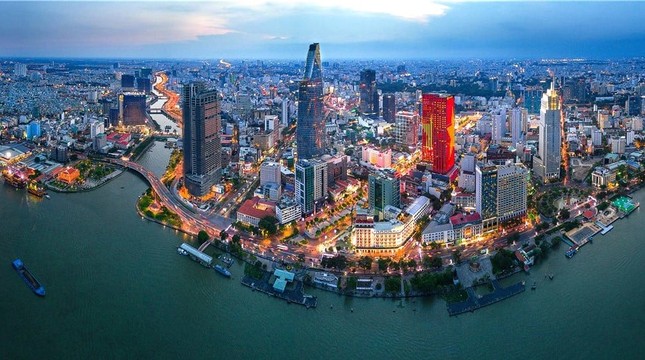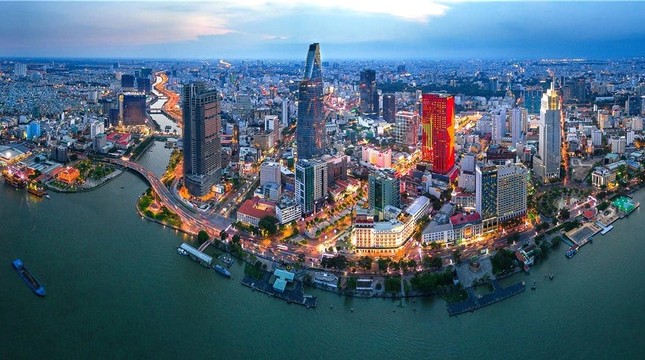In your opinion, are the conditions ripe for the establishment of the first Financial Center in Ho Chi Minh City and the regional Financial Center in Da Nang at this time?
Ho Chi Minh City accounts for a significant proportion of Vietnam’s GDP, approximately 23%, and serves as the hub for several key economic sectors, including finance, technology, and services. Da Nang, meanwhile, leads the provinces and cities in the South Central Coast region in terms of GRDP scale (in 2024). This dynamic business ecosystem fosters collaboration, growth, and innovation among domestic and foreign companies, providing a solid foundation for the development of an international financial center.
In terms of financial activity concentration, Ho Chi Minh City contributes 58% to the monetary market and a whopping 95% to the capital market (including equity and debt securities). The city boasts a relatively high level of financial inclusion, with a substantial number of large listed companies. Both Ho Chi Minh City and Da Nang demonstrate proactive capital market engagement, specifically through bond issuances and initiatives to upgrade the market to emerging status in the 2025-2030 period. The presence of both domestic and international financial institutions in Ho Chi Minh City and its surrounding satellite cities further underscores their readiness to become international financial centers.

Ho Chi Minh City (pictured) is set to establish an international financial center. Source: VGP
When it comes to financial service diversification, the region boasts one of the highest fintech digitization rates in the region and the world, coupled with significantly lower transaction costs compared to international financial centers. For instance, while opening a corporate account in Singapore requires a deposit ranging from $5,000 to $300,000 depending on the bank, such costs are negligible in Vietnam.
This direction is inevitable and lays a crucial foundation for deeper international integration and development for the two cities and the country as a whole.
Enhancing the Business Environment
What conditions, in terms of mechanisms, legal framework, and unique factors, are necessary for Ho Chi Minh City and Da Nang to become centers that attract substantial capital as international financial centers?
Based on theoretical frameworks and empirical studies of international financial centers in other countries, five factors determine the formation of such a center: business environment, high connectivity and convenience, human resources, financial infrastructure, and legal framework. Drawing on the experiences of financial centers in the US, Singapore, Hong Kong, and Shanghai, it is evident that Ho Chi Minh City and Da Nang, while possessing the basic foundations, need significant improvements across all five conditions. Achieving these improvements is not solely the responsibility of the two cities but also of the entire nation.
One of the most significant obstacles in establishing a financial center is the free flow of capital. Specifically, there should be a dedicated mechanism for Ho Chi Minh City and Da Nang to vigorously pursue the liberalization of currency convertibility and the removal of most controls on inbound and outbound capital flows. Additionally, the financial development strategies of the State Bank and the Ministry of Finance should outline a roadmap for financial liberalization nationwide. The limited presence of international financial institutions in Vietnam is partly due to the challenge of obtaining licenses to operate in diverse fields beyond traditional banking. Consequently, most international banks have primarily served FDI enterprises, and without the prospect of evolving into financial conglomerates, they have opted to withdraw capital, sell their stakes, or downsize their operations in the country. This challenge underscores the need for a legal framework that enables financial institutions to operate as financial conglomerates. These are the primary aspects that require improvement regarding the business environment.
Established international financial centers, comprising banks, insurance companies, securities firms, real estate companies, investment funds, gold exchanges, and commodity exchanges, offer diverse investment opportunities and attract substantial capital from numerous countries. They also serve as hubs for entrepreneurs to network and discuss business matters. Therefore, for Ho Chi Minh City and Da Nang to become international financial centers, they must provide similar investment channels and be strategically located.
Moreover, international financial centers foster collaboration among market participants, regulatory agencies, and other stakeholders. This includes sharing information and coordinating efforts to address emerging risks and challenges. Such collaboration enhances market efficiency, promotes innovation, and strengthens the overall resilience of the financial system. International financial centers also emphasize effective risk management measures, encompassing the supervision and management of various risks, including credit, market, liquidity, and operational risks. A robust risk management framework minimizes systemic risks and ensures the stability of the financial market. These are the key areas that Ho Chi Minh City and Da Nang need to refine to become international financial centers.

Professor Ngo Thang Loi
The establishment of financial centers also contributes to the development of high-quality financial human resources. Many international financial centers face a shortage of experts, particularly in the area of digitization. This underscores the importance of training professionals in fields such as law, accounting, and business services. Ho Chi Minh City and Da Nang must overcome the challenge of developing a highly skilled and specialized workforce and investing in labor force training. It is essential to enhance human resources through internationally recognized training programs in cybersecurity, AI, and cloud technology, attract international IT and fintech experts, and retain existing talented professionals during the establishment of the international financial center.
While Ho Chi Minh City and Da Nang have initially established basic technological foundations, significant improvements are needed in infrastructure, digital integration, and cybersecurity. Focused investments and strategic initiatives in these areas can propel the two cities closer to their goal of becoming international financial centers. However, to realize this vision, it is essential to develop a modern digital infrastructure with high-speed connectivity. This includes embracing digital banking technology and fintech innovations, rolling out 5G technology across the cities and eventually expanding it nationwide, establishing Tier 3+ data centers in sufficient quantities, integrating digital payment ecosystems to a high degree, and adopting advanced, AI-driven cybersecurity frameworks and solutions to counter threats and reduce vulnerabilities in the financial system. Additionally, it is crucial to adhere to stringent international standards for data protection and financial security.
In conclusion, there are numerous aspects that require refinement, and it is essential to recognize that becoming an international financial center (or even a regional financial center, as a first step) is not a straightforward endeavor. It requires more than political determination or a vague development strategy, as is currently the case in Ho Chi Minh City.
Attracting Top Talent
Is it challenging to attract talented individuals to financial centers when Vietnam has struggled with a shortage of high-quality human resources for many years?
When developing international financial centers, it is crucial to focus not only on hard infrastructure, such as physical facilities and technology, but also on soft infrastructure, including skilled human resources. It is important to recognize that we cannot compare ourselves to established international financial centers like Singapore, London, or New York. Our competitive advantage lies in our people.
However, the mechanisms to incentivize and attract this talent pool to Ho Chi Minh City and Da Nang, and Vietnam as a whole, are still lacking. In my opinion, we need to nurture and develop a high-quality workforce in areas such as finance, information technology, artificial intelligence, digital financial management, and various other fields.
The cities should allocate budgets for training high-quality human resources, including students and employees of enterprises, and empower the international financial centers to proactively send their personnel for training or recruit from these talent pools.
Additionally, we should implement mechanisms to attract Vietnamese talents with experience in international financial centers by offering competitive remuneration packages and providing the financial centers with the autonomy to determine their salary structures and implement special salary schemes. The two cities can also collaborate with leading international training centers to send their personnel for short-term training or internships at prominent international financial centers worldwide.
Currently, many Vietnamese students who pursue education abroad do not return to contribute to the country’s development, mainly due to low salaries compared to the cost of their education. To address this, we need to establish mechanisms to attract experts and talented individuals to build and operate the international financial center. It is essential to propose exceptional policies to the Central Government to attract high-quality human resources from around the world to live and work in the regional financial center of Da Nang.
Thank you for your insights.
Proposed Title: Proposal to Lift the Restraining Order on Millennium District 4 Project Transactions
“Phat Dat Real Estate Development JSC (HOSE: PDR) on May 29, 2025, revealed that the Ho Chi Minh City People’s Court’s first-instance verdict on May 13, 2025, pertained to the Millennium project located on a 132 Ben Van Don land lot in District 4.”
Unraveling the Red Tape: Prioritizing Title Deeds for Home Buyers
On May 30, the 5013 Task Force, led by Mr. Nguyen Toan Thang, Director of the HCMC Department of Agriculture and Rural Development, met with representatives of the investors of seven commercial housing projects in HCMC. The team included leaders from various departments, sectors, and the city’s Land Registration Office.
Summer Solstice 2025: Bustling Traditional Markets and Superstores’ Enticing Deals
The upcoming Tết Đoan Ngọ festival will see a surge in demand for traditional delicacies like bánh ú tro, com ruou, and gà cúng. Major supermarkets are well-prepared to meet this demand, offering a wide range of these festive treats under one roof. Not only do they provide convenience, but also exciting promotions and deals to celebrate this special occasion.
“A Province’s Ambitious $300 Million Project: A Secluded Island Retreat Spanning 118 Acres on the Embracing Dong Nai River”
The Kim Quy Island project is an impressive development, spanning over 48 hectares of land with a total investment of 7.2 trillion VND. This ambitious project comprises 571 units of detached and semi-detached villas and townhouses, offering a luxurious and exclusive lifestyle to its residents. With a vast array of amenities and a prime location, Kim Quy Island is set to become a prestigious and highly desirable address.





















